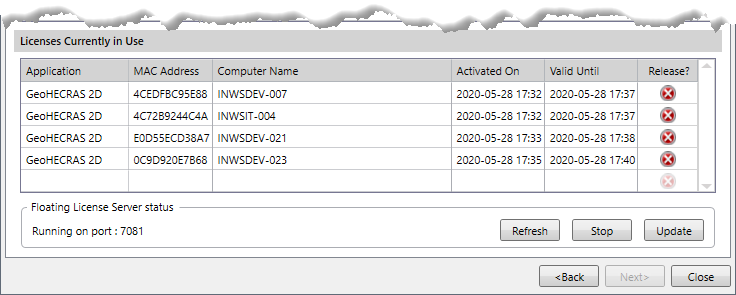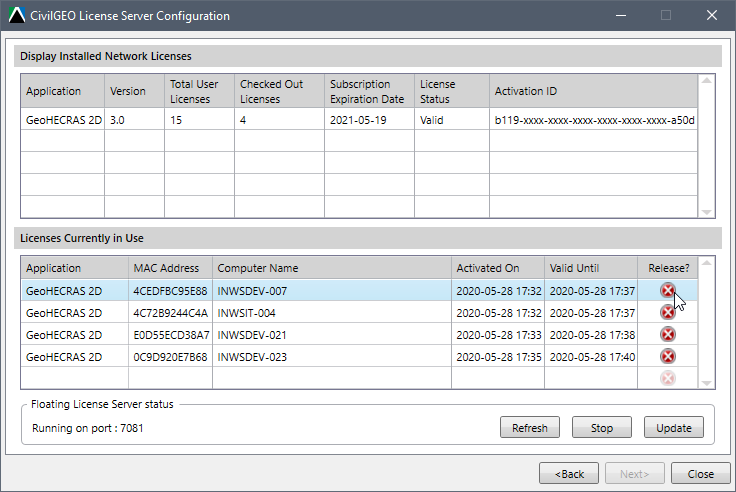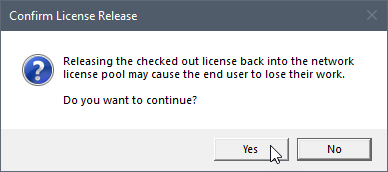
Welcome to CivilGEO Knowledge Base
Welcome to CivilGEO Knowledge Base

Welcome to CivilGEO Knowledge Base
Welcome to CivilGEO Knowledge Base
This article describes how LAN-Based Floating Network Licenses work and how to manage the licenses in a network environment.
For a stand-alone software license, a license needs to be installed on each computer workstation that the software is to run on. With a LAN-Based Floating Network License, a pool of licenses is available on a server for use by any computer workstation on the network. The number of network licenses available can correspond to the maximum number of simultaneous users expected, and not for each computer workstation where the software is to be installed. The major advantage of a Floating Network License is that any computer on the network can run the software—it is not “locked down” to an individual computer workstation. This enables more efficient work among the office staff since individual users can access the license whenever they need it. Additionally, software licensing is installed and activated only on the license server and not on the individual computer workstations. This allows computer workstations to be changed or upgraded more easily, without having to worry about uninstalling and reinstalling software licenses when changes occur.
LAN-Based Floating Network licenses require the Network License Server software to be installed on a Windows computer. The computer that the Network License Server is installed on can be any kind of computer (i.e., workstation or server), but must be assigned a static IP address for the CivilGEO software application to find the Network License Server. Although the Network License Server software does not require a powerful computer, it is necessary that the computer hosting the Network License Server be running and available on the TCP/IP network where other computer workstations will be used to access it.
The LAN-Based Floating Network License can be accessed over a WAN (Wide Area Network) containing multiple subnets. The network firewall settings may need to be adjusted to allow port communication with the Network License Server. This can be checked with a ping test using the client workstation and the computer in which the Network License Server is installed on.
The LAN-Based Floating Network Licenses are made available using the Network License Server software. This software is different than the product software. The product software, such as GeoHECRAS, is configured to contact the Network License Server at startup to request a license from the network license pool.
A LAN-Based Floating Network License allows the product software to be used on any computer workstation that can contact the Network License Server. A one-seat Floating Network License would allow the product software to be used by one user at a time. Similarly, a two-seat Floating Network License would allow the product software to be used by two users at the same time. Users sharing a Floating Network License can work on different computers, with the maximum number of simultaneous users being the number of network licenses (or “seats”) available.
When the user starts the product software, it requests a license from the Network License Server through the network. If a license is available, the Network License Server assigns a license to the computer workstation, and the number of available licenses in the network license pool is reduced by one.
When the user exits the product, the license returns to the network license pool. If the user runs multiple sessions of the same product on the same computer workstation, only one license is used. When the last product session is closed, the license is released back to the license pool.
Interacting with the Network License Server is performed using the CivilGEO License Server Configuration application. This application can be used to review the total available licenses, what licenses are currently in use, and other information. In addition, licenses can be forcibly removed from a computer workstation and returned to the network license pool.
This section describes how to determine the available network software licenses and which users (and their corresponding computers) have checked out a software license. Follow these steps:



The following sections describe the above dialog box in more detail.
This section displays the product name, the total number of available software licenses, the number of software licenses that are currently in use (checked out), and the subscription expiration date.
This section displays which computer workstations the product is currently running on. It will display the product name, the MAC address, and the name of the corresponding computer that is using the product, along with the date-time when the product was started up, and the validation date-time when the checked-out license would expire if the network connection to the computer fails. If there are no products currently in use, then this section will be empty.
The license validation date-time is used if the computer workstation gets disconnected from the network and cannot connect back to the License Server. The product issues a heartbeat back to the Network License Server to communicate that it is still in use. However, if the product crashes or the computer workstation suddenly powers off, this feature allows the license to be recovered without requiring any interaction with the user or IT staff. After the license validation date-time expires, the license will automatically return to the network license pool.

Note: Since the CivilGEO License Server Configuration application retrieves the computer workstation name from the DNS, it is necessary to scavenge the DNS (that is, remove old and false entries) for displaying the computer name. If the DNS has old data, the utility will display an old, invalid computer name. Click here to learn more about DNS scavenging and how to refresh the DNS records.
This section displays the status of the Network License Server, whether it is running or stopped, and the port number in which the Network License Server and the product communicate back and forth to each other.
The user can refresh the Network License Server status or stop the Network License Server by clicking the [Refresh] or [Stop] buttons, respectively.
If an incorrect port number is specified for either the Network License Server or the product, then the software license will not be able to be acquired across the network. If the specified port is blocked or disabled, this will cause the product on the computer workstation to fail because it cannot communicate with the Network License Server.
This section describes how to release a license that is in use, back to the network license pool so that the license can be used on another computer. Follow these steps:



The selected license will then be returned to the network license pool.
 1-800-301-02-955
1-800-301-02-955
 608-729-5100
608-729-5100
(US and Canada)
 [email protected]
[email protected]
 +1 608-729-5100
+1 608-729-5100
CivilGEO India
Graphix Tower, A-13 A
3rd Floor, Sector 62
Noida, Uttar Pradesh 201309
IndiaTel:
1-800-301-02-955 or
+91 022-3831-8601
CivilGEO United States
8383 Greenway Blvd
6th Floor
Middleton, WI 53562
USATel:
608-729-5100 or
800-488-4110
Copyright © CivilGEO, Inc. All rights reserved. The CivilGEO logo, “GeoSTORM”, “GeoHECHMS”, “GeoHECRAS”, and “Ready To Engineer” are registered trademarks of CivilGEO,Inc.
All other brands, company names, product names or trademarks belong to their respective holders.
We use cookies to give you the best online experience. By agreeing you accept the use of cookies in accordance with our cookie policy.
When you visit any web site, it may store or retrieve information on your browser, mostly in the form of cookies. Control your personal Cookie Services here.
The ZoomInfo WebSights snippet drops three cookies to track Unique Visits:
1. _pxhd - Related to the Perimeter X security layer (Perimeter X isused to prevent bot attacks).
2. _cfduid - Related to the CloudFlare security layer (CloudFlare is the Network Security protocol that ZoomInfo uses to orchestrate the rate limiting rules).
3. visitorId - This is how WebSights identifies recurring visitors








